|
FAQs on Chelmon
Butterflyfishes Infectious Disease
FAQs on Chelmon Disease:
Chelmon
Disease 1, Chelmon
Disease 2,
Chelmon Disease 3,
Chelmon Disease 4,
FAQs on Chelmon Disease by
Category:
Diagnosis,
Environmental,
Nutritional,
Trauma,
Infectious, Parasitic,
Social,
Treatments
FAQs on Butterflyfish Disease:
Butterflyfish
Disease 1,
Butterflyfish Disease 2,
Angels and Butterflyfishes &
Crypt,
FAQs on Butterflyfish Disease by
Category:
Diagnosis,
Environmental,
Nutritional,
Social,
Trauma,
Parasitic,
Treatments
Related Articles: Chelmon Butterflyfishes, Foods/Feeding/Nutrition,
Related FAQs: Chelmon Butterflies 1, Chelmon Butterflies 2, Chelmon Identification, Chelmon Behavior, Chelmon Compatibility, Chelmon Selection, Chelmon Systems, Chelmon Feeding, Foods/Feeding/Nutrition,
Using Chelmons as Aiptasia Controls, Butterflyfish Identification, Butterflyfish
Foods/Feeding/Nutrition, Butterflyfish
Compatibility,
Butterflyfish Behavior,
Butterflyfish Systems, Butterflyfish Selection, Butterflyfish Disease,
Butterflyfish
Reproduction,
|
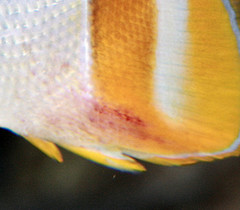
|
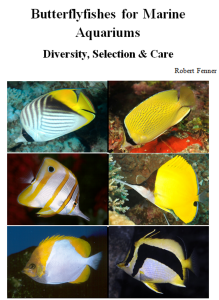 |
Butterflyfishes for Marine Aquariums
Diversity, Selection & Care
New eBook on Amazon: Available
here
New Print Book on Create Space: Available
here
by Robert (Bob) Fenner |
|
Copperband - lumps near eyes
9/21/16
Hello wet web media crew
<Hey Kel>
Seeking some advice please on lumps that are growing on either side of my
Copperband's nose (see photos)
<I see these... in your pix they appear bi-symmetrical... some sort of growth
(microbial, poss. a viral component) in part of the lateralis system of the
fish>
Bit of his history. I have had him nearly 3 years. He refuses to eat commercial
food and exists solely on live food that I grow for him. Live black worms and
gut loaded 1 week old Artemia - plus I now grow macro algae in part of my
display (sigh) to maximise pod production. Not really a fortified diet (of
course making him less resistant to disease) but the
live food has stopped him from starving these years.
<Yes; concur>
And yes I have tried every trick to transition him to frozen, pellet or fresh
seafood.
<Ahh>
He is the last fish I added to the tank i.e. 3 years ago and no other
inhabitants (Lineatus Wrasse trio, Tang, Citron Goby pair and clown pair) have
any bumps or lesions.
<I see>
He is otherwise healthy, active and very friendly. I have noticed his food
capture skills are diminishing - he some times misses food on first strike - so
I assume the lumps are now interfering with his line of sight.
I would hate to lose him. Any help appreciated.
Thanks Kelly.
<A few treatment modalities to try come to mind. To "overdose" the system water
(pulsing) with vitamin, HUFA, pro-biotic... supplement/s that you've been
soaking foods in; along with Iodide-ate applied to water and.... daubing the
solution straight/strength on the sites... with carefully netting, lifting the
Chelmon from the water, holding in a soft towel...
using a Q-tip.... The usual steps to assure optimized, stable water quality...
High RedOx esp. a useful indicator; the use of chem. filtrants (PolyFilter and
Chemipure faves).... IF the growths don't abate, moving this fish to where
specific gravity can be dropped precipitously, applying aggressive
antimicrobials there (which we can/will chat over later if nec.).
Bob Fenner>
|
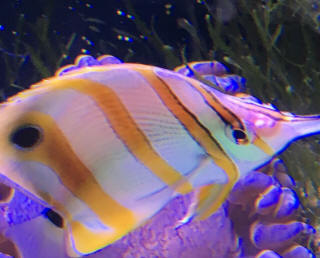
 |
Chelmon Lymphocystis
4/8/15
Hey Bob, I've had a CBB in a 55 qt for about 6 days now. After nipping at live
rock for 2 days he finally started eating vitamin soaked PE mysis.
He's been eating about 6-8 shrimp a day and is active. It did have a
little "lymph" when I got it, but has gotten worse since.
<Quite common; and I would expedite this (and all Butterflyfishes) through
quarantine... likely do a preventative dip/bath and place straight away. NOT to
worry re the Lymph... easily defeated, not often spread...>
The water quality is great; 1.022 SG,
<Mmm; would keep more NSW, 1.025-6>
ammonia and nitrites at 0, nitrates at about 20 and it is the only fish in the
tank. There is plenty of LR plus I'm running a Fluval 406 with ceramic media
seeded from my main sump. I've been reading about possibly transferring
him to the DT, but am nervous.
<Don't be>
It's only been 6 days, so it could still have ich theoretically, also the lymph
will eventually explode and possibly spread.?
<No... see, READ on WWM re>
My 150g DT inhabitants are as follows... Black dogface puffer (7"), teardrop
butterfly (4"), comet (6"), Flagtail Blanquillo (7"), orange tail filefish (4"),
and a long nosed hawk (3").
The DT is extremely healthy and active and has been for about 2 years.
Do you think I should be patient here, or risk transferring him.
<I would definitely do the latter>
Another worry of mine is that he'll have a lot of competition for food and may
perish unless I keep him where he is to "fatten him up a bit".
Especially the file fish who is the fastest most voracious eater I've ever seen
:) Any thoughts? Thanks!
-Jay
<Welcome. Bob Fenner>
|
Fluke surviving Muelleri Butterflyfish in QT with bacterial
infections (?) 10/13/13
Greetings,
<Good eve Sarah>
A friend of mine recommended you with the highest regard. I've
attached a cell phone picture (I don't have a regular camera, sorry) of
the affected area on my Butterflyfish. I've had him 15 months, he
eats live blackworms and a homemade frozen seafood blend.
Parameters are good in the quarantine.
The photo: Below the glare line in the middle brown stripe the lesion
like area is visible. There is some redness, the scales are raised,
inflammation is visible from the profile view and there are a couple
white apparatus' attached next to the inflammation. The white apparatus
will begin small and hard like, very bright white and after a couple
days grows larger and more flesh like, hangs off the fish (can visibly
see it moving as he swims) and then falls off. Above the glare line is
an example of one that can be seen moving in the current as the fish
swims. A 5 min fw dip didn't seem to affect the area.
<... have you looked at this material under a 'scope?>
I dosed Kanamycin into the water 2 days ago, also have been feeding in
frozen food. It seems too early to know if it's working.
Currently, the fish is eating, but hiding in his pvc most of the
time.
Additionally, he had a lower jaw (inside the mouth) infection that is
now reoccurring.
Thank you for your time.
Sincerely,
Sarah
<I suspect the white material is simply "mucus" (body slime)... an
exudate... from...? Not curable w/ antibiotics, nor
quarantine/isolation.
Do you suspect there is a parasite here? I would move this fish back to
the main/display system. Bob Fenner>
|
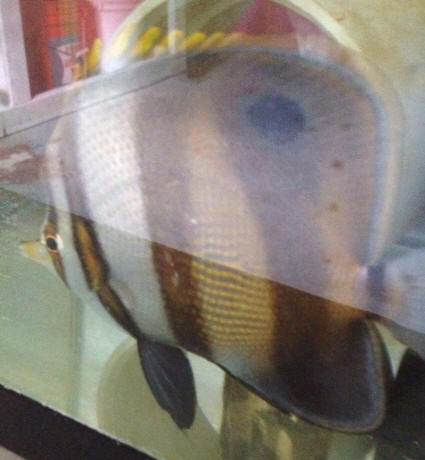 |
|
Re: Fluke surviving Mueller Butterflyfish in QT
with bacterial infections (?) 10/14/13
Thank you, Bob. I've been actively looking for someone to look under a
'scope, although, I'm concerned about increasing the fish's stress level as
he's been in hiding except for feeding time for several days.
<You are wise here... life is indeed "a series of compromises", and you are
right to consider the trade-off in handling this (or any) specimen>
This fish has undergone 17 days Praziquantel treatment (unsuccessful)
followed by 23 days Formalin, which I believe, effectively eliminated the
flukes.
<... am very surprised it didn't eliminate the fish>
I feel the lesions/mouth infection are some sort of secondary ailment - i
have read flukes are like portals for other diseases.
<Can be>
I do not know if there's some sort of parasite at this time.
<Highly unlikely... grossly appears to be "sores"...>
The fish's name is Ziggy.
<"Ziggy played guitarrrrrrrr" Bowie>
I appreciate your time.
Sarah
<And I everyone's. BobF>
Re: Fluke surviving Muelleri Butterflyfish in
QT with bacterial infections (?) 10/15/13
Good Day Bob,
<Sarah>
Took Ziggy in this morning for a biopsy. The man said there is no mucus
by the sores (which is bad), so he pulled a scale via tweezers
and looked under the 'scope.
<Good>
He told me there are no parasites (I assumed) and that
the infection seems to be coming from the inside out.
<Yes>
All he could say is that it's bacterial and suggested running a
full 5 day course of antibiotics, which I have been (Kanamycin - in food
too) with today being the 5th day. Lastly, he said to begin treating
tomorrow with a Nitrofuracin product because they are absorbed well.
<Yes; better... though best would be to do a rudimentary sensitivity
test/run... >
I have a seeded identical QT and could treat with NFP Nitrofuracin green
powder immediately or I could wait out the day with the Kanamycin
treatment like the man suggested?
<I'd just stop the one and start t'other if you're adamant re
such antibiotic/antimicrobial treatment (I am not... most such
treatments are more destructive than useful... microbial issues
starting w/ other causes... mostly environmental, social, nutritional...
and cured by fixing the same. Moving, isolating specimens... is much
more likely to kill them>
I'm reluctant to wait and "see what happens," yet, very cautious.
He also said the fish looks very healthy aside from the bacterial
infection.
<Yes; all the more reason why I'd move it... not treat>
For the past few days, the fish has been hiding in a pvc and reluctantly,
(which is a new development) ate a few live blackworms today.
Sincerely,
Sarah
<Cheers, B>
PS - I am very thankful to have found your site, will donate.
|
|
Chelmon Muelleri with likely infection
12/16/13
Greetings,
<Sarah>
I have a well established 120 gal reef system, in Aug I introduced flukes
via snails and had an epidemic. My Chelmon Muelleri survived and has
been the only fish in the tank (was reintroduced Oct 26th) since the others
weren't as fortunate.
<I see>
After the fluke infestation was treated I've been battling secondary
infections with this fish, all were healed when suddenly he's developed a
rather large bump (~3/8") behind and above his eye. There is slight
underlying redness and seems slightly irritated. My question is does
this warrant erythromycin in food for 10 days or would it be wise to simply
observe?
<I think so. Unfortunately "what it takes" to actually sample, culture and
test for resistance/efficacy in the way of anti-microbials isn't "worth the
damage" here (in my perception, experience of course)>
I've attached two pictures from when the lights are out, strangely that's
when I get the best pictures-you can see the redness and the bulge.
Sincerely,
Sarah Hlavenka
<I would instead seek to boost immunity, recovery via optimized, stable
conditions and improved nutrition (HUFA, vitamin soaking of foods). Bob
Fenner>
|
.JPG)
.jpg) |
Re: Chelmon Muelleri with likely infection
12/16/13
Basically he said treat with optimal water conditions, fatty acid and immune
system supplements.
<Ah yes. BobF> |
|
Copperband Butterfly with Bacterial
Infection 7/31/11
Hello WWM Crew,
<Carolyn>
After many years of reading through your wonderful website, I now
have a question that I think needs a more direct answer.
<Am answering this immediately due to the critical nature of this
condition>
I obtained a healthy Copperband Butterfly (Chelmon rostratus) about
4 months ago. Wednesday night I noticed a small spot on his side
where it looked like the scales were protruding with a slightly red
tint. I wasn't overly concerned as the fish was acting normal, but I
thought it best to get another opinion. I posted a picture up on my
local reef club forum and was told by a knowledgeable fish store
owner that it was likely a bacterial infection.
<It is>
It was too late to go to any stores so I started mixing up some
saltwater in case I had to get my QT set up. Thursday morning I
drove to the fish store and picked up Seachem NeoPlex and Seachem
Focus, which was recommended to me by the owner. Since my fish was
still eating I decided to try treating orally and leave it in the
display tank. I mixed the NeoPlex and Focus in with my usual mix of
frozen and fresh foods, fed my fish, and froze the rest. I have been
feeding this medicated food to my fish about 3 times a day starting
on Friday.
<Mmm... the first not likely to be of use; the second... Furan cpd.s
can be efficacious... depending on the source of (stress) as
causative agents here... Was this Chelmon exposed to copper? What
other tankmates are there?>
Yesterday, it looked like the fish's scales were peeling away, but
there didn't appear to be much redness and the fish was acting
normal (still eating and foraging through the rocks). This morning,
the spot looks even worse and the redness is back. I have attached
some photos. Sorry about the quality, I had to use my cell phone
camera. I know antibiotics take a little time to get into the
system, but I am thinking at this point the medicine should be
working?
<These are worthy products, but this condition is almost impossible
to arrest...>
The fish is still eating and swimming around but seems a little less
responsive and hides in the rocks more often. Should I continue with
my current treatment or try something else?
<Well... I do suspect this is Vibriosis...
Oxytetracycline can be tried (in foods best) or potentiated
Sulfonamides... Unfortunately, this fish will very likely succumb
soon>
My tank is a standard 6' 150 gallon tank with plenty of live rock
and a deep live sand bed, a sump with more live rock, carbon, and
skimmer. Last water test was performed on Friday and results were:
no detectable ammonia, nitrite, or nitrate and pH of 8.3.
Temperature has been a little high but stable at 82-83 degrees.
Other inhabitants include: 5 Blue/Green Chromis (Chromis viridis), 1
Ocellaris Clownfish (Amphiprion ocellaris), 1 Coral Banded Shrimp
(Stenopus hispidus), and a mix of soft, LPS, and mushroom corals.
All other fish appear healthy. A 29g QT is setup and ready to go
should it be necessary.
<I would not move this fish>
Thank you for taking the time to answer my question. Any help you
can provide is greatly appreciated.
Carolyn
<Please do inform us as to your actions, the disposition of this
fish. Bob Fenner>
|
|
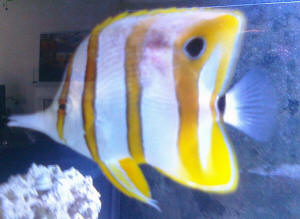
|
Re: Copperband Butterfly with Bacterial Infection 8/1/11
Thank you for the quick response. The Copperband has not been
exposed to any copper, at least not in the 4 months that I have had
it. The Chromis follow the Copperband around but I have never seen
them pick on him. My tank has a low bioload and I am very diligent
with water changes so my water is fairly stable. I am willing to try
one of the medicines you recommended. Would these only be available
through a vet?
<Mmm, depending on what country you're in; possibly>
If the fish continues to decline I will euthanize it but I would
like to try everything possible before giving up. This is a
beautiful fish and quickly became my favorite and I hate to see this
happen.
<I am of the "don't give up" habit... Have seen fishes recover from
these bacterial "break down" syndromes; but it's rare>
Thank you again for all your help.
Carolyn
<Welcome. Bob Fenner>
Re: Copperband Butterfly with Bacterial
Infection 8/1/11
Thank you for all the help. Sadly the Butterfly did not make it.
<Ahh, as suspected/mentioned. One last but important statement I
should have made: DO thoroughly wash your hands, arms after they've
been in this system, or after handling this dead fish>
He was eating and swimming around last night, although a bit
lethargic. I woke up this morning to find him dead.
I did find a source for tetracycline
<Oxy...>
so hopefully I can someday use what I have learnt and aid other
fellow hobbyists. I am blessed to have a wonderful local reef club
(Atlanta Reef Club)
<Ah, yes. Have met w/, spoken to them a few times>
with great people always willing to help out. In fact, if you ever
find yourself in the area I am sure we would love to have you as a
guest speaker for one of our meetings. The Georgia Aquarium is
definitely worth a visit if you haven't been. :)
<Have done both, would do again>
Thanks again for everything you contribute to this hobby and for
taking the time to help others.
Carolyn
<Welcome. Bob Fenner>
|
Re: Randall's Goby and a Neon Goby, Now
Chelmon exp. -- 11/09/2009
Hi Bob
<Ged>
Just a quick note to let you know how I got on with the
Copperband.
As you know I got him on 17th October and he had a bad case of
Lymphocystis.
I was going to get a Neon Goby to help him out. However, I never
did. I ended up getting 2 cleaner shrimps and kept on top of my
water properties.
I upped from a 20ltr to a 40ltr per week change, and changed
carbon etc etc
I am glad to report that his Lymphocystis has completely
disappeared and there are no signs on any of my other fish of
catching it from him.
He eats a combination of a little flake, all of my Aiptasia and
Mysis and garlic brine shrimp (frozen alternated every 2 days or
so) and seems to have really settled into his new home. He is
approaching me, in the corner of the tank, whenever I walk into
the room.
My only other concern, is how much to feed, I feed seaweed on a
clip every 2 days, flake a couple of times per day, algae pellets
every other day, and frozen brine / Mysis every other day. Is
this too much, or too little for my current stocking levels, as
per original (below) email.
<Not too much>
Thanks for your time taken to reply to me, and your website is
invaluable, with plenty of help and advice for someone like me
who is new to the hobby!
Regards
Ged
<Thank you for this update, input. BobF>
|
Lymphocystis - Chelmon rostratus 1/6/2008
Dear Crew, <Andy> Good morning. I'm sending you
two separate messages, because they deal with separate
issues and I know they might get sorted among different
Crew members. <Ok> Here's the first! I purchased
a Chelmon rostratus, not only because it has always been
one of my favorite fishes but also because I have about 10
or 15 Aiptasia growing in my display that I'm hoping it
will eat. The butterfly has been in my 30g QT for 7 days
now. <I would move it to the main display> When I
purchased it, I made sure it was eating at the LFS. For the
first 2 days after I brought it home, it ate well--frozen
Mysis and blood worms. After day 2, however, it stopped
eating. I had done my research on the fish beforehand, so I
knew these fish can be finicky eaters. So, I got on WWM to
research what others have done in similar circumstances,
and I discovered that what I am experiencing is not
uncommon and that the advice has been to get some live rock
in the QT to get the fish to graze the worms, etc. on the
rock. It just so happened that I have a few pieces of LR
that were not supporting other pieces of LR and that host
some Aiptasia, so I decided to throw 2 pieces in the QT. I
placed the first piece in (which had about 8 Aiptasia) and
went back for the second. By the time I got back to the QT,
all the Aiptasia were gone. I thought, "this could not
be." Sure enough, though, this morning they are still
gone (along with a very pretty orange feather duster that
hiked in on the rock--oh well). The Chelmon has pretty much
denuded my LR of any worms, etc. So . . . Thanks for the
advice! <Welcome> ANYWAY, my question really relates
to 2 masses on the tail and pectoral fin of my Chelmon,
shown in the attached photos. Based on my research, I
believe that the fish simply has Lymphocystis, but would
like your concurrence. <I do agree> If so, I
won't hesitate to put him in the display after the 3-4
week QT if all else goes well. If it's something else,
then I'll proceed accordingly. <I would place this
fish now... this is much more an "environmental"
or stress condition than a type of pathogenic disease...
Won't be "catching"...> Thanks as always
for your time/help. Andy (Although I realize (think) that
15 Aiptasia is not an infestation by any stretch, I am
trying to figure out why they are appearing. <Some
cellular material must have been introduced at some
point... likely on/with LR, but could be algae...> I
have cut down feeding to once per day--usually frozen Mysis
or blood works, or Formula 1 flake. I employ a 30g fuge
with Chaeto, DSB and LR. I run Phosguard in the sump. I
have tested my display water, my RO/DI water, and my
storage water for phosphates and silicates--I have two test
kits--a Seachem (color never matches test strip) and a
Salifert (really hard to read!). No silicates are present.
The Seachem kit shows 0.1 phosphates (or 0.01, can't
remember the scale) in all three sources; the Salifert
shows 0, so I'm befuddled). <No need or use... Bob
Fenner>
Re: Lymphocystis - Chelmon rostratus
1/6/2008 Thanks, Bob. I presumed that everything
needs a long QT period, but it seems that with the
Copperband 8 days is enough as long as it isn't showing
other signs of disease/reason to keep in QT? <... please
re-read... "I would..."> I don't
understand your last response, "no need or use"
re my phosphate kits/readings. Would you mind explaining?
Thanks again. <These readings for soluble PO4 are in
agreement within the limitations of the test gear.
B>
|
|
 
|
Lymph on Copperband butterfly
12/2/07 Hello, Thanks for all of the help in the past and the
great site. I will try and keep this short. I have read through
the Lymph FAQ's and couldn't find what I need. I
received a Copperband from LiveAquaria.com about 2 weeks ago, I
put him in my 20 long quarantine and after a couple of days I
noticed the white clumps developing on his fins. They have spread
to his tail and even some on his body. He eats extremely well,
only Mysis though (I have noticed in the past that I only have
luck getting Copperbands to eat "white" food, anything
to this?) <Don't know... but interesting speculation>
which I soak in Selcon. I have read that there is no direct cure
for this and that good water quality and food are the best
medicine, there is also a cleaner goby with him but I don't
see him clean him though. My question is, would you keep him in
quarantine until it goes away or would you put him in the
display? <I would do the latter... This viral complaint is
"not that infectious" and yet, won't begin to
self-cure unless the Chelmon is "in a better place">
The only fish in the display are a tomato clown, lawnmower
blenny, and very expensive juvenile chevron tang. <Oh! Just
wrote a piece for this Ctenochaetus sp.... one of a few while am
out in HI... "in spare time"...> Thanks for all of
the help. Merry Christmas, Jeremy <I do hope the frenatus
clown doesn't go after your Butterfly. Only experience will
tell... do remove/float the clown in a plastic colander for a few
days if apparently so. Cheers, BobF>
Re: Lymph on
Copperband butterfly 12/18/07 Just wanted to let you
know that the Copperband is looking great now. He is still eating
and seems to be happy. I removed the tomato clown just in case,
as I had seen it chasing the chevron and noticed the fins on the
chevron looked "nipped". He is still eating great so I
assume they will grow back. Any reason to think it was caused by
anything else? <Mmm...> Only a few small crabs, lawnmower
blenny, and butterfly with him in the tank. Looking forward to
reading your article on the Chevy tang on the website. Have a
great Christmas. Jeremy <Will download after it runs in
print... have attached here for your perusal. Cheers,
BobF>
Need Help with Diagnosis:
Copperband Butterfly 09/17/07 I purchased a Copperband
Butterfly fish on Friday (9/14) from an online vendor. I
noticed some redness on the bottom right and left sides of
this fish today (Sunday, 9/16). The eyes and fins are clear.
I have pics of this fish located here:
http://www.flickr.com/photos/7329275@N05 <Bad scrape...
likely a thrashing with being roughly netted in the
wild...> The fish is not eating yet, prolly still
recovering from his trip. Is this a viral or bacterial issue?
Is this something that can be treated? If so, with what?
<May become bacterial... No "treatment"
suggested other than good care...> The other fish in the
tank <... this fish was not quarantined? Mistake> are a
pair of cinnamon clownfish and a gold spotted Rabbitfish. The
clownfish have been in the tank for 2.5 months and the
Rabbitfish for one month. they are healthy and are eating
vigorously. Salinity- 1.024 Nitrates-0 Ammonia-0 Nitrites-0
Calcium-420 Alk-3.43 Temp 80.6 Any advice and suggestions are
appreciated. Thanks Kirk
<Read... on WWM re Chelmon care... Bob Fenner> |
|

|
 |
Butterflyfishes for Marine Aquariums
Diversity, Selection & Care
New eBook on Amazon: Available
here
New Print Book on Create Space: Available
here
by Robert (Bob) Fenner |
|
|

